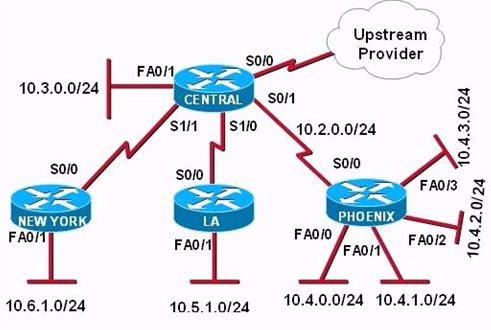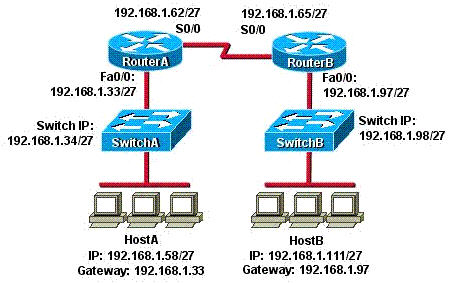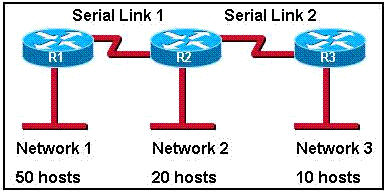Subnetting Questions
Here you will find answers to ICND 2 – Subnetting Questions
Note: If you are not sure about subnetting, please read my Subnetting tutorial.
Question 1:
Refer to the exhibit. The lakeside Company has the internetwork in the exhibit. The Administrator would like to reduce the size of the routing table to the Central Router. Which partial routing table entry in the Central router represents a route summary that represents the LANS in Phoenix but no additional subnets?

A – 10.0.0.0 /22 is subnetted, 1 subnet
D 10.0.0.0 [90/20514560] via 10.2.0.2 6w0d, serial 0/1
B – 10.0.0.0 /28 is subnetted, 1 subnet
D 10.2.0.0 [90/20514560] via 10.2.0.2 6w0d, serial 0/1
C – 10.0.0.0 /30 is subnetted, 1 subnet
D 10.2.2.0 [90/20514560] via 10.2.0.2 6w0d, serial 0/1
D – 10.0.0.0 /22 is subnetted, 1 subnet
D 10.4.0.0 [90/20514560] via 10.2.0.2 6w0d, serial 0/1
E – 10.0.0.0 /28 is subnetted, 1 subnet
D 10.4.4.0 [90/20514560] via 10.2.0.2 6w0d, serial 0/1
F – 10.0.0.0 /30 is subnetted, 1 subnet
D 10.4.4.4 [90/20514560] via 10.2.0.2 6w0d, serial 0/1
Answer: D
Question 2:
Refer to the exhibit. HostA cannot ping HostB. Assuming routing is properly configured. what could be the cause of this problem?

A – HostA is not on the same subnet as its default gateway.
B – The address of SwitchA is a subnet address.
C – The Fa0/0 interface on RouterA is on a subnet that can’t be used.
D – The serial interfaces of the routers are not on the same subnet.
E – The Fa0/0 interface on Routers is using a broadcast address.
Answer: D
Question 3:
Refer to the exhibit. The routers are running RIPv2. Which addressing scheme would satisfy the needs of this network yet waste fewest addresses?

A – Network 1: 1 92.168.10.0/26
Network 2: 1 92.168.10.64/26
Network 3: 1 92.168.10.128/26
Serial link 1: 192.168.20.0/24
Serial link 2: 192.168.30.0/24
B – Network 1: 1 92.168.10.0/26
Network 2: 1 92.168.10.64/28
Network 3: 1 92.168.10.80/29
Serial link 1: 192.168.10.88/30
Serial link 2: 192.168.10.96/30
C – Network 1: 1 92.168.10.0/26
Network 2: 1 92.168.10.64/27
Network 3: 1 92.168.10.96/28
Serial link 1: 192.168.10.112/30
Serial link 2: 192.168.10.116/30
D – Network 1: 1 92.168.10.0/27
Network 2: 1 92.168.10.64/28
Network 3: 1 92.168.10.96/29
Serial link 1: 192.168.10.112/30
Serial link 2: 192.168.10.116/30
Answer: C


I do not unerstand Q1 that how did you narrow down the right answer, could anyone help in this regard plzzz?
To Ahsan:
Since 3 octet is the only diference, put this octec first in binary to understand which are the bits are the same on that octec:
10.4.0.0=10.4.0000 0000.0
10.4.1.0=10.4.0000 0001.0
10.4.2.0=10.4.0000 0010.0
10.4.3.0=10.4.0000 0011.0
As you can see from left to right we have 22 bits that are the same 8(1st octec)+8(2rd octect)+6(3th octect) = that makes /22 the summary address.
The summary ip therefore would be:
10.4.0.0/22
with mask=255.255.11111100.0 = 255.255.252.0
Can someone help out with Q1 I’m fine with the autosummarization of the network i am just unclear on how the eigrp summary route was determined
Auto-summarization and/or the Routing protocol are not really relevant in this question.
The bottom line is 10.4.0.0/22 encompasses the 4 LAN networks attached to the PHOENIX Router, that the CENTRAL Router needs to know about.
I understan that 10.4.0.0/22 encompasses the 4 LAN Networks attached to the PHOENIX router. However the answer is very confusing:
D – 10.0.0.0 /22 is subnetted, 1 subnet
D 10.4.0.0 [90/20514560] via 10.2.0.2 6w0d, serial 0/1
There is no 10.0.0.0/22 network in the question. And the secod line 10.4.0.0 has no mention of the subnet mask. So the ip address is on the second line, the subnet mask is on the first line and I don’t know what the point of 10.0.0.0 is. Why is the route summary written like this?
10.0.0.0 is the default ip of Class A that is why it is written.
all these questions and the labs are on pass4sure does anyone use pass4sure and if so what do you think??
” gillman
October 26th, 2010
all these questions and the labs are on pass4sure does anyone use pass4sure and if so what do you think?? ”
Hey i don’t really trust it fully cause there are a lot of mistakes , belive me 9tut is the right place to be … i am going for my icnd2 very soon , good luck.
I do not unerstand Q2 that how did you narrow down the right answer, could anyone help in this regard plzzz?
The question gives /27 as the netmask for the serial connections. If that’s the case the host ranges is incremented by 32. Thus the ranges of valid (usable) hosts will look like this:
1st Range: 192.168.1.1 – 192.168.1.31
Second Range: 192.168.1.33 – 192.168.1.63 (Router A resides here)
Third Range: 192.168.1.65 – 192.168.1.91 (Router B resides here)
Question 1. It wants you to summarize the routes so you don’t have to put each route into central’s routing table or waste routes by being to broad by not summarizing.
Say if another branch location popped up in Oklahoma and wanted to use 10.4.4.0/24. Well, it couldn’t. Even though the 10.4.4.0/24 isn’t being used, the central router will still route packets destined for that space to phoenix.
To solve:
First we know all the subnets in Phoenix are class B… /16
So now we know the 3rd octet can be manipulated to reach our goal.
10.4.(3).0 3rd octet 00000011 = 3. So, we only need two bits for the host in the 3rd octet.
the other 6 bits will be used for the networking portion.
11111111. 11111111. 11111100 00000000 = 255.255.252.0 = /22
ooops, i meant class A for the last one 🙂
thank you Jeff!
Have you recently passed the ICND2, or is prepping?
9tut can you please help me understand question 1.
Mo, Pay close attention to the following portion of this question…..
Which partial routing table entry in the Central router represents a “route summary” that represents the LANS in Phoenix but no additional subnets?
when you see “ROUTE SUMMARY, SUMMARIZED, you know it’s going to be VLSM!
I would find your nearest download file/Bookstore and practice VLSM subnetting….
Gravy!
Hope this helps…
Vash
Are these questions actually on the exam or are they just guides of what you might be asked.
These questions are very close to what is on the exam. The subnets and node names, and so forth will be different, but the basic idea is the same. I would not go through 9tut and memorize the answers if that’s what you are looking for.
ICND2 Failed! 703
i m pretty sure that question 2 was asked about a month ago..
too bad i could not get time to comple the exam..
the questiones are getting bigger and bigger …
And 9tut is becoming less reliable when it comes to rare exams like ICND2 when compaired to CCNA as a whole.. 🙁
i say less reliable cos only 2 or 3 questions out of the whole ICND2 website was on the real exam..
can someone explain the answer to the question 3
Is anyone else concerned that in Question 2, Router A has both interfaces FA0/0 and S0/0 in the same subnet?
ie: 192.168.1.33 / 27 and 192.168.1.62 / 27 both belong to the 192.168.1.32.0 / 27 network.
To me this represents a problem because each interface will be listed in the route table with access to the same 192.168.1.32.0 network. The router will probably load balance between the two interfaces?
Other than this I agree with the answer given (D).
@twigonometry
yes, you’re right, both interfaces are in the same subnet.
still, the only option that we can pick there is “The serial interfaces of the routers are not on the same subnet”.
can any one tell answer for this question?how identify network id and broadcast adress 172.16.4.2 tell with and example pleae!!
Anonymous, do you have the mask??? You need to have the mask to figure the broadcast and network you are on.
^^ Can we just say that 172.16.4.2 is a class B address, so default mask is 255.255.0.0
Network ID is 172.16.00
Broadcast is 172.16.255.255
Is this correct?
@Anonymous: To solve your question, we need to know the subnet mask of 172.16.4.2 because different subnet mask will give different network and broadcast addresses.
Passed ICND2 today with 944!! I didn’t have any of these on my exam today
Guys help me out with this subnet dillema.
I have a subnet of 10.57.80.0 255.255.240.0
Now I need to find out the last host IP for this network, I calculated that to be 10.57.94.254 but the book says it’s 10.57.95.254, what am I missing here? I have 96 being the subnet number of the first new subnet and .95 being the broadcast for the .80 subnet leaving .94 as the last IP address. Can someone shed some light on this for me?
Thanks.
@Kevin
10.57.80.0/20
1st host: 10.57.80.1
last host: 10.57.95.254
A trick for subnetting is 256- 240=16
If your next subnet is 10.57.96.0 then you will get the broadcast address of the prior subnet on 10.57.95.255, meaning that the last host is 10.57.95.254
you have to start remember that 240=4 1’s that is equal to 16. 4^4.
1—-128 the increment is 128 (subnets)
2—–192 the increment is 64
3—-224 the increment is 32
4—-240 the increment is 16
5—-248 the increment is 8
6—-252 the increment is 4
7—-254 the increment is 2
8—-255 the increment is 1
I am sorry not 4^4 it is 2^4. lol
I will take mine on march 23.
kevin get the CBT nuggets vids made by jeremy, if you follow his way of subnetting youll ALWAYS get it right i havent gotten a single subnet Q wrong in any cisco exam by following his ways
@Xalax
can u plz explain this question
Given IP address 172.16.28.252 with a subnet mask of 255.255.240.0, what is the correct network address ?
correct answer is 172.16.16.0
how can it be with 16 increment ???
@kratos
the increment isnt 16
the increment is 16.0
how did i end up with that?
you subtract the value of the incomplete octet from 256.
256-240=16
keep in mind that this is the 3rd octet so add .0 and that’s your increment: 16.0
random examples:
for a subnet mask of 255.240.0.0 the increment is 16.0.0
for a subnet mask of 255.255.128.0 the increment is 128.0
for a subnet mask of 255.254.0.0 the increment is 2.0.0
see? 256-(incomplete octet) and you add 0s for the remaining octets
@Xalax thanks a lot 🙂
@Xalax
can u plz also explain this one
Which subnet does host 172.24.199.102 255.255.240.0 belong to?
the answer is 172.24.192.0
So I’m just trying to understand the correct route summary to enter into the Phoenix router. Is this the correct route summary or am I way off?
PHOENIX(config)#router eigrp 1
PHOENIX(config-router)#network 10.4.0.0 0.0.3.255
@kratos
same thing, the increment is 16.0 for a subnet of 255.255.240.0
now look at the given ip: 172.24.199.102
199.102
if you go up 16 by 16 you will eventually get to:
…
160.0 ~ 175.255
176.0 ~ 191.255
192.0 ~ 207.255 — the subnet on which 172.24.199.102 is
…
172.24.192.0/20 is the answer
So I’m just trying to understand the correct route summary to enter into the Phoenix router. Is this the correct route summary or am I way off?
PHOENIX(config)#router eigrp 1
PHOENIX(config-router)#network 10.4.0.0 0.0.3.255
or do you summarize from the Central Router as the following?
PHOENIX(config)#ip route 10.4.0.0 255.255.252.0 10.2.0.2
Passed with 944, got one drag and drop question very similiar to Q3.
The question I referred to above is Q1 at http://www.9tut.com/ccna-drag-and-drop-questions.
Also, another drag and drop question here http://www.9tut.com/ccna-drag-and-drop-4 Q4
Thanks Xalax 🙂
@Xalax one more thing i cant understad why access list number should be 128 ???? how did they get it ?
All hosts in the same subnet with 172.16.5.118/26 must be denied telnet access to hosts outside the LAN (u need to just drag & drop) fiil out the command
ACCESS-LIST list-number DENY TCP 172.16.5.address 0.0.0.mask ANY EQ port
list number=128
address=64
mask=63
port=23
options to choose from 0,1,128,80.25564,63
there is nothing pointing to use 128 instead of 1 in a question
sorry i have exam tomorrow 🙂
thanks
@ Xalax
sorry never mind
should be between 100-199
Passed ICND2 today with 986/1000 🙂
i had Question same idea of Q3
hello 9tut,
only these 3 subnetting questions are enough for icnd2 exam?
how many subnetting question its going to be on icnd2 exam?
is it like icnd1 exam with a lot of subnetting questions?
do u recommend to practicing all the subnetting questions on ccna page?
I’m confused i don’t know to study all ccna page or just icnd2!
yo john, study what you need. if you already took icnd1 than you really only “need” icnd2. the ccna covers icnd 1 and 2. but to master this you have to use as many resources as possible. do as much as possible. challenge yourself during your studies and the exam will be easy. do any and everything on this site that is ccna related. it will only help you and make icnd2 easier. do all the questions until u r comfortable with all of them. if you dont feel confident then you havent done enough.
can some body tell me why E is right answer for this
the network administrator is asked to configure 113 point-to-point links. Which IP addressing scheme best defines the address range and subnet mask that meet the requirement and waste the fewest subnet and host address ?
A-10.10.1.0/25 SUBNETTED WITH MASK 255.255.255.252
B-10.10.0.0/16 SUBNETTED WITH MASK 255.255.255.252
C-10.10.0.0/18 SUBNETTED WITH MASK 255.255.255.252
D-10.10.1.0/24 SUBNETTED WITH MASK 255.255.255.252
E-10.10.0.0/23 SUBNETTED WITH MASK 255.255.255.252
I think it’s A why E
Thanks , I have recently been searching for info about this subject for a while and yours is the greatest I have discovered till now. However, what about the conclusion? Are you sure concerning the source?|What i do not realize is if truth be told how you are no longer really a lot more smartly-appreciated than you might be now. You’re very intelligent.
@Fasad-ksa
Becouse you need 113 poin-to-point links or 4 ip adresses peer link one is network two for interfaces and one is broadcast, 113*4=452 addresses.
The /23 has 512-2 ip addresses and the waste is the smallest with /23.
Sorry for typo mistakes…
@Fahad-ksa
E is the answer.
u need to borrow 7 host bits to get 113 subnets.
2*2 = 4 4*2 =8 8*2=16 16 *2=32 32 *2=64 64*2=128 or (2^7)
1 = network bits
0 = host bits
255.255.11111110.0000000
seven number 1(ones) borrowed.
That’s going to give you 8bits (1st octet) + 8bits (2nd) + 7bits (3rd) = 23 hence /23
255.255.254.0 /23
All of them have a /30 mask which is ideal for point to point links
Hope this helped..
@@Fahad-ksa
Btw if you use a /25 that means you borrowed 9 host bits which would
give you 2^9= 1024 1024 subnets is too many.
you only need 113 so 7 bits is enough. 2^7 = 128
thanks.
ooops sorry 2^9 is 512 subnets..
I had the question posed in the comments by Fahad-ksa on my test today.
I came up with E.
my reasoning behind this was:
1) each point-to-point network was using 4 addresses (because of the .252 mask)
2) breaking an entire octet down into 4 block networks gives you 64 subnets
3) needing 113 subnets meant I needed to borrow one more bit from the network side, which would then give me 128 subnets, and thus /23
q1 where there today
I have exam next week in ccna and I need dums
Next week I will take my first exam in CCNA … I hope to pass … I want to know if I failed can I retake exam on August 2013 without any additional fees
Also I want to know how many questions (multiple choise , simulation ????? is there possible to review the question after answering
http://www.9tut.com down…can someone let the admin know
Question 3 D is the correct answer. For network 1 /26 will waste too much IP addresses. /27 leaves room for 12 extra host for future growth/
@Mike – a /27 subnet for network one gives you a 32increment increase?
how to you propose to fit 50 hosts in with a 32 increment?
Q1 and Q2 in ICND2 today
Fail. Took the supposed ICND2 640-816 today and there was nothing like the material contained on this site. No VTP, No VLSM, No Drags and Drop (except 1, had Split Horizon), no ACL or NAT. It was all about SNMP and Netflow. 2 Different SIMS OSPF and EIGRP (not on this site or dump) A lot IPV6. I nailed ICND1 exam but this wasnt the test I prepared for. Please reply.
I like to mess with people.
So TrickedbyCisco…
Did you take the test? If Yes… the 640-816 still has these question?
’cause I’m tatkng the test on Saturday.
MJ
This site is completely valid for 640-816 exam! For some crazy reason my exam overlapped and I got 200-100. Didnt know was there already and Fail 788/1000. Passing Score is 825. 200-100 has a lot of SNMP, Netflow and IPV6. Got 3 SIMS OPSF, EIGRP and The Frame Relay one. Only 1 or 2 Drag and Drop. 640-816 next Monday.
Does anyone have any recent information on the Service Provider cert for Cisco?
Thank you for helping out, great info. “Considering how dangerous everything is, nothing is really very frightening.” by Gertrude Stein.
http://www.bastcilkdoptb.com/
I’m still confuse with the answer in Q2. I think its C.